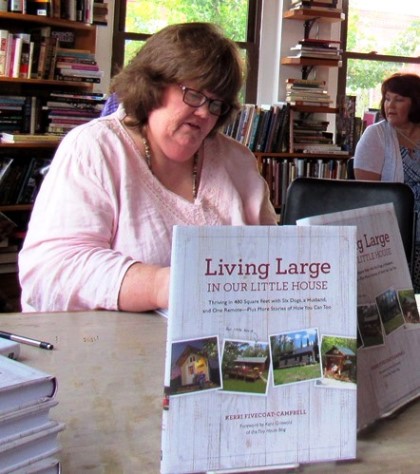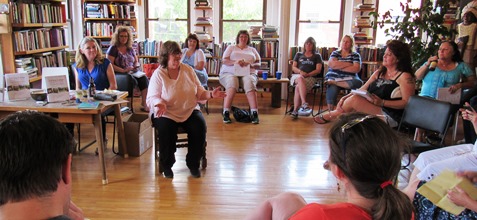by Rebecca Tombaugh
Everybody dreams of writing a book and getting it published.
And one ol’ Dotte has gone and done it.
“I still pinch myself,” says Kerri Fivecoat-Campbell.
Kerri — raised, schooled, married, worked, buried her parent in, fought city hall and the entire state of Kansas for “Scruffy’s Bill,” and has lived most of her life in Kansas City, Kan., — has published her book, “Living Large in Our Little House: Thriving in 480 Square Feet with Six Dogs, a Husband, and One Remote–Plus More Stories of How You Can Too.”
Released this month, it’s gone big-time.
Real big.
It was published by Reader’s Digest, and it’s currently listed on Amazon with a whole bunch of five-star reviews.
“This is a great book for anyone interested in downsizing, whether to a tiny house, smaller house, or just uncluttering and staying where you are…” says one reviewer.
“What I love about Campbell’s book is that it takes a straight forward and candid look at life in a tiny house. Her superb writing style really draws you in…” says another reviewer,
Kerri currently lives in Mountain Home, Ark., and came back last week for the book launch party and signing at Prospero’s in Kansas City, Mo. Her next book signing is at 2 p.m. Saturday, June 25, at Books-A-Million at The Legends Outlets in Kansas City, Kan.
“These are my peeps, this is my home,” she gushes.
She’s also had a few articles written about her book, including CountryLiving.com, MSN.com and Today.com. She’s even done a photo shoot for an upcoming article about cooking in small spaces for “Where Women Cook.”
Kerri’s name may be familiar to Wyandotte Countians not just because she’s a Turner graduate but also because she has been a journalist for a couple decades. She wrote for many newspapers and magazines in the Kansas City area, including The Kansas City Star, and The Pitch, and many other publications that have since closed their doors. She’s won a lot of awards, too, for her writing.
But, she says, her first love was covering the news for The Kansas City Kansan.
“They embraced me because I was a native,” she recalls. ”I fell in love with it. I got to cover my own hometown.”
“Our community was a working-class railroad community – the railroads ran right through the end of town. Most men in Turner either worked at the railroad, like my father, or at one of the many businesses that supported the railroad, like my father-in-law, who worked for a company that made wheels for railroad cars.” – from “Living Large in Our Little House

Her lucky break getting published started in 2009, when she went to New York for a writing convention and met a woman who was connected to Reader’s Digest. Kerri pitched her book idea to her and she loved it and had Kerri send a query letter. The book was still in flux, but Kerri kept in touch with her, and, in 2014, she felt ready to go forward with it.
“I was so excited,” she said.
“People in the (Tiny House) movement had discovered that the American Dream wasn’t about having bigger homes and accumulating more stuff. It was about living (not just having) and doing what’s important with those you love.” – from “Living Large in Our Little House”
The hardest part, says Kerri, is not the writing.
“Putting yourself out there,” she says.
“The key to Living Large is having enough stuff to live and be happy, but not so much that it is cluttering your life.” – from “Living Large in Our Little House”
She did not know how the book would be received.
“I still pinch myself,” she says.
“In that summer of 2007, when we moved full-time into Our Little House, we had three dogs. … We also had our two senior cats. … All were rescues, or what I like to call ‘recycled’ pets – animals no one else wanted but who fit into our family perfectly.” – from “Living Large in Our Little House”
Since moving to Mountain Home, Ark., she has continued to write as a freelancer. Kerri says she and her husband considered moving back last year. But until the pit bull law is repealed, that might not happen.
“We couldn’t never give up our dogs,” she says.
“We truly learned to appreciate what we have here: a cozy little house we designed and built. We know every nook and cranny, and we know it doesn’t have major structural issues. We love our ‘neighborhood’ of trees and wildlife, and the humans who are here are spaced far enough apart so that we all have room to ourselves.” – from “Living Large in Our Little House”
So now, with one book under her belt, Kerri says she is tossing around a few ideas for a spin-off.
“We’ll see…” she muses.
Editor’s note: Rebecca Tombaugh is a freelance writer and artist in the Greater Kansas City area. She was the managing editor of The Kansas City Kansan at the time that Kerri was a freelance writer there.


